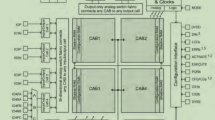Abstract
Among other uses, oversampling can be useful for systems that aim to accurately estimate the time delay between two signals. Due to the simplicity of its implementation, \(\varSigma \varDelta \) analog-to-digital converters have been largely used when oversampled signals are required. In this work, two methods for parallel evaluation of the discrete Fourier transform (DFT) of \(\varSigma \varDelta \) signals are presented, targeting frequency domain analysis of oversampled signals. The basic proposed method relies on the partial storage of DFT outputs in memories, considering binary inputs and using a technique named bitstream decomposition to reduce the dimensionality. Additionally, the basic method has been combined to the Cooley–Tukey algorithm to derive a more efficient method. When compared to conventional strategies to compute partial DFTs sequentially, the proposed methods had shown similar results, using feasible memory resources. However, the method allows highly parallel implementations with linear increase in performance as new processing units are added. It has been shown that its implementation on FPGA not only may improve performance but may also reduce memory utilization in more than 80%, enabling low resource FPGAs to compute the FFT of oversampled \(\varSigma \varDelta \) sequences.








Similar content being viewed by others
References
S.S. Abeysekera, C. Charoensak, FPGA implementation of a sigma-delta architecture based digital if stage for software radio, in 15th Annual IEEE International ASIC/SOC Conference, 2002 (IEEE 2002), pp. 341–345
S. Bouguezel, M.O. Ahmad, M. Swamy, Efficient pruning algorithms for the DFT computation for a subset of output samples, in Proceedings of the 2003 International Symposium on Circuits and Systems, 2003. ISCAS’03, vol. 4 (IEEE 2003), p. IV
D.E. Castro-Palazuelos, M.G. Medina-Melendrez, D.L. Torres-Roman, Y.V. Shkvarko, Unified commutation-pruning technique for efficient computation of composite DFTs. EURASIP J. Adv. Signal Process. 2015(1), 100 (2015)
J.H. Cheong, Y.Y.H. Lam, K.T. Tiew, L.M. Koh, Sigma-delta receive beamformer based on cascaded reconstruction for ultrasound imaging application. IEEE Trans. Ultrason. Ferroelectr. Freq. control 55(9), 1935–1946 (2008)
J.W. Cooley, J.W. Tukey, An algorithm for the machine calculation of complex Fourier series. Math. Comput. 19(90), 297–301 (1965)
V. da Fonte Dias, Signal processing in the sigma-delta domain. Microelectr. J. 26(6), 543–562 (1995)
A. Daglio, P. Malcovati, F. Maleberti, A multiplier-free digital RMS calculation unit for integrated microsystems, in Proceedings of the 3rd International Workshop on Design of Mixed-Mode Integrated Circuits and Applications, 1999 (IEEE 1999), pp. 183–186
C. Dick, F. Harris, FPGA signal processing using sigma-delta modulation. IEEE Signal Process. Mag. 17(1), 20–35 (2000)
C.P. Fan, G.A. Su, Pruning fast fourier transform algorithm design using group-based method. Signal Process. 87(11), 2781–2798 (2007)
M. Freedman, D.G. Zrilić, Nonlinear arithmetic operations on the delta sigma pulse stream. Signal Process. 21(1), 25–35 (1990)
S.R. Freeman, M.K. Quick, M.A. Morin, R.C. Anderson, C.S. Desilets, T.E. Linnenbrink, M. O’Donnell, Delta-sigma oversampled ultrasound beamformer with dynamic delays. IEEE Trans. Ultrason. Ferroelectr. Freq. Control 46(2), 320–332 (1999)
G. Goertzel, An algorithm for the evaluation of finite trigonometric series. Am. Math. Mon. 65(1), 34–35 (1958)
H.S. Han, J.J. Kim, T.K. Song, Hardware-efficient methods for elimination of signal distortion in sigma-delta-based ultrasound beamforming. Ultrason. Imaging 31(1), 101–119 (2009)
H. Hassanieh, P. Indyk, D. Katabi, E. Price, Simple and practical algorithm for sparse Fourier transform, in Proceedings of the 23rd Annual ACM-SIAM Symposium on Discrete Algorithms (Society for Industrial and Applied Mathematics, 2012), pp. 1183–1194
S. Hirata, M.K. Kurosawa, T. Katagiri, Accuracy and resolution of ultrasonic distance measurement with high-time-resolution cross-correlation function obtained by single-bit signal processing. Acoust. Sci. Technol. 30(6), 429–438 (2009)
D.A. Johns, D.M. Lewis, Design and analysis of delta-sigma based IIR filters. IEEE Trans. Circuits Syst. II Analog Digit. Signal Process. 40(4), 233–240 (1993)
R. Kaald, Analysis of the distortion mechanism in delta-sigma beamforming. IEEE Trans. Ultrason. Ferroelectr. Freq. Control 63(9), 1380–1389 (2016)
O.E. Liseth, D. Mo, H.A. Hjortland, T. Sverre, D.T. Wisland et al., Power-efficient cross-correlation beat detection in electrocardiogram analysis using bitstreams. IEEE Trans. Biomed. Circuits Syst. 4(6), 419–425 (2010)
F. Maloberti, Non conventional signal processing by the use of sigma delta technique: a tutorial introduction, in Proceedings of the 1992 IEEE International Symposium on Circuits and Systems, 1992. ISCAS’92, vol. 6 (IEEE 1992), pp. 2645–2648
J. Markel, FFT pruning. IEEE Trans. Audio Electroacoust. 19(4), 305–311 (1971)
M. Medina-Melendrez, M. Arias-Estrada, A. Castro, Input and/or output pruning of composite length FFTs using a DIF–DIT transform decomposition. IEEE Trans. Signal Process. 57(10), 4124–4128 (2009)
I.D.S. Miranda, A.C.C. Lima, Impulsive sound detection directly in sigma-delta domain. Arch. Acoust. 42(2), 255–261 (2017)
K. Nagai, Pruning the decimation-in-time FFT algorithm with frequency shift. IEEE Trans. Acoust. Speech Signal Process. 34(4), 1008–1010 (1986)
P. O’leary, F. Maloberti, Bit stream adder for oversampling coded data. Electron. Lett. 26(20), 1708–1709 (1990)
S. Park, Principles of Sigma-Delta Modulation for Analog-to-Digital Converters. Motorola Inc., APR8/D, Rev. 1 (1990)
R. Schreier, G.C. Temes et al., Understanding Delta-Sigma Data Converters, vol. 74 (IEEE Press, Piscataway, 2005)
J. Schumacher, M. Puschel, High-performance sparse fast Fourier transforms, in 2014 IEEE Workshop on Signal Processing Systems (SiPS) (IEEE 2014), pp. 1–6
D. Skinner, Pruning the decimation in-time FFT algorithm. IEEE Trans. Acoust. Speech Signal Process. 24(2), 193–194 (1976)
H.V. Sorensen, C.S. Burrus, Efficient computation of the DFT with only a subset of input or output points. IEEE Trans. Signal Process. 41(3), 1184–1200 (1993)
T. Sreenivas, P. Rao, High-resolution narrow-band spectra by FFT pruning. IEEE Trans. Acoust. Speech Signal Process. 28(2), 254–257 (1980)
N. Thong-un, S. Hirata, M.K. Kurosawa, Three-dimensional-positioning based on echolocation using a simple iterative method. AEU-Int. J. Electron. Commun. 69(3), 680–684 (2015)
B.G. Tomov, M.B. Stuart, M.C. Hemmsen, J.A. Jensen, A Delta-Sigma beamformer with integrated apodization, in SPIE Medical Imaging Conference 2013 (2013)
Author information
Authors and Affiliations
Corresponding author
Additional information
Publisher's Note
Springer Nature remains neutral with regard to jurisdictional claims in published maps and institutional affiliations.
Rights and permissions
About this article
Cite this article
Miranda, I.D.d.S., Lima, A.C.d.C. An FPGA-Oriented FFT Algorithm for Sigma-Delta Signals. Circuits Syst Signal Process 39, 2459–2472 (2020). https://doi.org/10.1007/s00034-019-01265-0
Received:
Revised:
Accepted:
Published:
Issue Date:
DOI: https://doi.org/10.1007/s00034-019-01265-0




